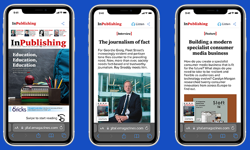
The phone on my desk started ringing. It was a colleague from head office in Hamburg, bringing good news. Following the largely successful migration of Empire, Car, Bike and Practical Photography magazines to their new apps, I’d been invited to Berlin for a couple of days to talk product roadmap with the developers and attend a brainstorm with them.
So, it was that one evening in February, just as Storm Doris was revving up, that I found myself on a bumpy budget flight to Schönefeld Airport, two days of strategic app discussion and German hospitality (which usually involves sausages and beer) ahead of me.
The agenda was long. It included a debrief on how the app migration went and learnings we could implement for future projects. Mistakes made (and oh yes, we made a few), successes enjoyed, frustrations endured. Ways in which we might be able to increase engagement with the app and, resultantly, revenues.
I’ve already mentioned in this column before how we need to engage with our readers through their phones if we’re to stand any chance of digital specialist content sales and associated revenues reaching such a level as to reinvigorate – at least in part – the fortunes of the publishing industry. So, phone strategy was highest on our list of subjects to debate.
It’s really not rocket science. All you need to do is check out the analytics of Grazia’s app, which is optimised for phone and tablet, to see how engagement through tablets is falling, in terms of visits, downloads and time spent reading digital editions, while smartphone usage moves gently upward in the opposite direction. The trends are stark enough to make me wonder what the tablet’s future is, four or five years hence, and back up my thoughts that iPads and the like were only ever intermediary devices existing until smartphone tech became good enough to make their larger brethren obsolete.
Anyway, what really jumped out at me on our German brainstorm was this: if an app is to sell a publisher’s digital content and be successful, it needs to work on every level. And there are so many levels to set-up, operate and monitor. You fail on one of them, it’ll cost you. You fail on multiple elements of an app’s performance, you’re in real trouble. If you sit back and relax when it comes to maintenance of the app, you’re going to see declining downloads, installations and revenues. So, what is the successful recipe for a profitable app that adds to your ABCs?
First up, and most importantly, your marketing has to be on the money and your app must be optimised for search in its respective app store. I’ve said it before, but just launching something into the vastness of the digital space and leaving it there is a fast-track route to no downloads.
You need to make your customers aware of the app’s existence and help them find it. And, more importantly, you need to help people who AREN’T aware of your brand find it. Otherwise, how are you going to grow?
All this can only be effectively done via a multi-channel marketing strategy, involving websites and good SEO; a plan for ASO (app store optimisation) to improve your app’s rankings; a carefully targeted multi-platform social strategy and maybe a smart PPC campaign where you can carefully monitor performance and ROI via good attribution tracking.
Getting the customer to the right place in the app store is only half the problem. Once there, you have to persuade them to install your app through your fabulous screenshots, app description and (hopefully) a 4 or 5-star app rating.
App ratings
Ah, the app rating system: the scourge of the digital publisher. Empire, before its migration, had a fantastic app, rated at 4.5 stars in the Apple App Store. Immediately after migration, 1-star reviews proliferated, which was demoralising, because the new app is absolutely no worse than its predecessor. The issues are still brilliantly crafted and fully interactive. In fact, the new software is better for us, because internal workflows have become so much more efficient and license fees slashed, saving time and money.
I’m sure Empire’s star rating will rise again when people get used to the new app and after we release some performance updates. But still, how many of you have baulked at installing a 1-star app because of its rating? I know I have. So, the migration definitely cost us, though we’ll never know how much – and all through something that was largely out of our control.
Getting someone to download the app is half the battle won. A download is a customer entering your tunnel of love, so to speak; the start of your chance to engage with them intimately and win them over – not just with top-quality specialist interactive content that is laser-targeted to their personal interests, but with a slick in-app experience and integrated CRM tools.
With good attribution tracking, push-priming and CRM, you can see where your users have come from and see which marketing strategies are working best. You can utilise analytics to track behaviours, collecting data as you go. You can segment databases and communicate with your readers via pushes (and emails, if you can get email addresses). You can offer specific subs deals to specific datasets.
In our brainstorm, we ran through all this. We ran through the importance of having a smart user interface (a really good UI is one of our current weaknesses) and talked about learning from the gaming industry and the likes of Pokémon Go. (Don’t laugh – I’m being serious! In Pokémon Go, if you enter the app every day, you start a ‘seven day streak’ that results in more experience points, more prizes and more chance of catching one of those rare monster things. Why not something similar in a digital magazine app, with the reward of a free issue when you complete a weekly engagement-related ‘task’?)
But then, of course, you hit the problem that the majority of your magazines are periodical editions, and – again from our analytics – we know that engagement in our apps is negligible for 25 out of 30 days every month. Even on the weeklies, engagement is only strong on the day of publication, the day after and maybe for a day over the weekend. Three days out of seven, max. What an opportunity, wasted.
So, we talked about incorporating continuous publishing in our apps, pushing content from our dedicated websites into the app – done in such a way that Bauer’s websites still get their traffic figures and ad views, but allow us to engage daily or hourly with people who adore the specialist content we’re serving them.
When you wake up in the morning and look at your phone, you might check out Facebook first. Then you might check out the news. Or Twitter, or Snap, or Instagram. But the third or fourth app you launch? We want that to be one of ours. We want to become your habit. And, if we’re making apps that are easy to engage with and give consumers content they have a personal affinity with and love of, then why shouldn’t our apps become a habit?
People at the top of the publishing game are often sceptical about the potential of digital magazines. “They will never work”, they say. Rubbish, I say! Of course they can work. In the five years I’ve been running Bauer’s ePublishing business, I’ve delivered year-on-year growth each and every year, in terms of revenues and digital edition downloads.
But you need to get EVERY part of the equation bang on the money. Then you need to keep it that way. And that’s not easy.










